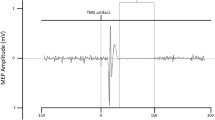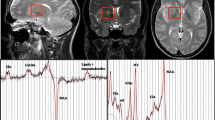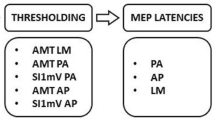Abstract
Studies in which single- and paired-pulse TMS was applied during motor task performance have shed considerable light on the functional relevance of popular TMS-derived neurophysiological biomarkers such as short-interval intracortical inhibition (SICI) and long-interval intracortical inhibition (LICI). While it has become well established that corticospinal excitability and intracortical inhibition are modulated during the enactment and cancellation of actions, it has remained unclear as to whether interindividual differences in these neurophysiological markers were associated with an individual’s actual ability to restrain and cancel actions. In this study, we found that individual differences in both SICI and LICI were positively associated with relevant performance metrics on the go/no-go task and stop-signal task. Specifically, we found that individuals with greater resting SICI and LICI were faster to respond on go trials of the go/no-go task and were also more accurate at inhibiting their manual responses on both go/no-go and stop-signal tasks. These results are in support of findings from our earlier study and also provide new evidence for a general relationship between individual differences in resting-state GABAergic intracortical inhibitory functioning and motor inhibition.







Similar content being viewed by others
References
Benwell NM, Sacco P, Hammond GR, Byrnes ML, Mastaglia FL, Thickbroom GW (2006) Short-interval cortical inhibition and corticomotor excitability with fatiguing hand exercise: a central adaptation to fatigue? Exp Brain Res 170(2):191–198
Bütefisch CM, Boroojerdi B, Chen R, Battaglia F, Hallett M (2005) Task-dependent intracortical inhibition is impaired in focal hand dystonia. Mov Disord 20(5):545–551
Chikazoe J, Jimura K, Asari T, Yamashita K-I, Morimoto H, Hirose S, Konishi S (2008) Functional dissociation in right inferior frontal cortex during performance of go/no-go task. Cereb Cortex 19(1):146–152
Chowdhury NS, Livesey EJ, Blaszczynski A, Harris JA (2018) Variations in response control within at-risk gamblers and non-gambling controls explained by GABAergic inhibition in the motor cortex. Cortex 103:153–163
Chu J, Wagle-Shukla A, Gunraj C, Lang A, Chen R (2009) Impaired presynaptic inhibition in the motor cortex in Parkinson disease. Neurology 72(9):842–849
Cirillo J, Cowie MJ, MacDonald HJ, Byblow WD (2017) Response inhibition activates distinct motor cortical inhibitory processes. J Neurophysiol 119(3):877–886
Cowie MJ, MacDonald HJ, Cirillo J, Byblow WD (2016) Proactive modulation of long-interval intracortical inhibition during response inhibition. J Neurophysiol 116(2):859–867
Coxon JP, Stinear CM, Byblow WD (2006) Intracortical inhibition during volitional inhibition of prepared action. J Neurophysiol 95(6):3371–3383
Coxon JP, Stinear CM, Byblow WD (2007) Selective inhibition of movement. J Neurophysiol 97(3):2480–2489
Darling WG, Wolf SL, Butler AJ (2006) Variability of motor potentials evoked by transcranial magnetic stimulation depends on muscle activation. Exp Brain Res 174(2):376–385
Daskalakis ZJ, Farzan F, Barr MS, Maller JJ, Chen R, Fitzgerald PB (2008) Long-interval cortical inhibition from the dorsolateral prefrontal cortex: a TMS–EEG study. Neuropsychopharmacology 33(12):2860
Duque J, Murase N, Celnik P, Hummel F, Harris-Love M, Mazzocchio R, Cohen LG (2007) Intermanual differences in movement-related interhemispheric inhibition. J Cogn Neurosci 19(2):204–213
Duque J, Greenhouse I, Labruna L, Ivry RB (2017) Physiological markers of motor inhibition during human behavior. Trends Neurosci 40(4):219–236
Enticott PG, Kennedy HA, Rinehart NJ, Tonge BJ, Bradshaw JL, Fitzgerald PB (2013) GABAergic activity in autism spectrum disorders: an investigation of cortical inhibition via transcranial magnetic stimulation. Neuropharmacology 68:202–209
Ficarella SC, Battelli L (2019) Motor preparation for action inhibition: a review of single pulse TMS studies using the Go/NoGo paradigm. Front Psychol 10:340. https://doi.org/10.3389/fpsyg.2019.00340
Filipović SR, Rothwell JC, van de Warrenburg BP, Bhatia K (2009) Repetitive transcranial magnetic stimulation for levodopa-induced dyskinesias in Parkinson’s disease. Mov Disord 24(2):246–253
Fujiyama H, Tandonnet C, Summers JJ (2011) Age-related differences in corticospinal excitability during a Go/NoGo task. Psychophysiology 48(10):1448–1455
Greenhouse I, King M, Noah S, Maddock RJ, Ivry RB (2017) Individual differences in resting corticospinal excitability are correlated with reaction time and GABA content in motor cortex. J Neurosci 37(10):2686–2696
Hanajima R, Ugawa Y (2000) Intracortical inhibition of the motor cortex in movement disorders. Brain Dev 22:132–135
He JL, Fuelscher I, Coxon J, Barhoun P, Parmar D, Enticott PG, Hyde C (2018) Impaired motor inhibition in developmental coordination disorder. Brain and cognit 127:23–33
Hermans L, Leunissen I, Pauwels L, Cuypers K, Peeters R, Puts NA, Swinnen SP (2018) Brain GABA levels are associated with inhibitory control deficits in older adults. J Neurosci 38(36):7844–7851
Hinder MR, Puri R, Kemp S, Waitzer S, Reissig P, Stöckel T, Fujiyama H (2018) Distinct modulation of interhemispheric inhibitory mechanisms during movement preparation reveals the influence of cognition on action control. Cortex 99:13–29
Hirose S, Chikazoe J, Watanabe T, Jimura K, Kunimatsu A, Abe O, Konishi S (2012) Efficiency of go/no-go task performance implemented in the left hemisphere. J Neurosci 32(26):9059–9065
Ilić TV, Meintzschel F, Cleff U, Ruge D, Kessler KR, Ziemann U (2002) Short-interval paired-pulse inhibition and facilitation of human motor cortex: the dimension of stimulus intensity. J Physiol 545(1):153–167
Kleine BU, Praamstra P, Stegeman DF, Zwarts MJ (2001) Impaired motor cortical inhibition in Parkinson’s disease: motor unit responses to transcranial magnetic stimulation. Exp Brain Res 138(4):477–483
Kumru H, Albu S, Rothwell J, Leon D, Flores C, Opisso E, Valls-Sole J (2017) Modulation of motor cortex excitability by paired peripheral and transcranial magnetic stimulation. Clin Neurophysiol 128(10):2043–2047
Leunissen I, Zandbelt BB, Potocanac Z, Swinnen SP, Coxon JP (2017) Reliable estimation of inhibitory efficiency: to anticipate, choose or simply react? Eur J Neurosci 45(12):1512–1523
Liepert J, Storch P, Fritsch A, Weiller C (2000) Motor cortex disinhibition in acute stroke. Clin Neurophysiol 111(4):671–676
Logan GD, Cowan WB (1984) On the ability to inhibit thought and action: a theory of an act of control. Psychol rev 91(3):295
Macdonald HJ, Coxon JP, Stinear CM, Byblow WD (2014) The fall and rise of corticomotor excitability with cancellation and reinitiation of prepared action. J Neurophysiol 112(11):2707–2717
Manson SC, Palace J, Frank JA, Matthews PM (2006) Loss of interhemispheric inhibition in patients with multiple sclerosis is related to corpus callosum atrophy. Exp Brain Res 174(4):728–733
McDonnell MN, Orekhov Y, Ziemann U (2006) The role of GABA B receptors in intracortical inhibition in the human motor cortex. Exp Brain Res 173(1):86–93
Nelson A, Hoque T, Gunraj C, Ni Z, Chen R (2010) Impaired interhemispheric inhibition in writer’s cramp. Neurology 75(5):441–447
Opie GM, Semmler JG (2014) Age-related differences in short-and long-interval intracortical inhibition in a human hand muscle. Brain Stimul 7(5):665–672
Opie GM, Rogasch NC, Goldsworthy MR, Ridding MC, Semmler JG (2017) Investigating TMS–EEG indices of long-interval intracortical inhibition at different interstimulus intervals. Brain Stimul 10(1):65–74
Perera T, George MS, Grammer G, Janicak PG, Pascual-Leone A, Wirecki TS (2016) The clinical TMS society consensus review and treatment recommendations for TMS therapy for major depressive disorder. Brain Stimul 9(3):336–346
Rossini PM, Rossi S (2007) Transcranial magnetic stimulation: diagnostic, therapeutic, and research potential. Neurology 68(7):484–488
Rothwell J, Day B, Thompson P, Kujirai T (2009) Short latency intracortical inhibition: one of the most popular tools in human motor neurophysiology. J Physiol 587(1):11–12
Samusyte G, Bostock H, Rothwell J, Koltzenburg M (2018) Short-interval intracortical inhibition: comparison between conventional and threshold-tracking techniques. Brain stimul 11(4):806–817
Schmidt-Wilcke T, Fuchs E, Funke K, Vlachos A, Müller-Dahlhaus F, Puts NAJ, Edden RAE (2018) GABA—from inhibition to cognition: emerging concepts. Neuroscientist 24(5):501–515
Sohn YH, Wiltz K, Hallett M (2002) Effect of volitional inhibition on cortical inhibitory mechanisms. J Neurophysiol 88(1):333–338
Stagg C, Bestmann S, Constantinescu A, Moreno Moreno L, Allman C, Mekle R, Rothwell J (2011) Relationship between physiological measures of excitability and levels of glutamate and GABA in the human motor cortex. J Physiol 589(23):5845–5855
Tendler A, Sisko E (2018) TMS for OCD transcranial magnetic stimulation in neuropsychiatry. IntechOpen, New York
Tendler A, Zohar J, Carmi L, Roth Y, Zangen A (2018) O14. Deep TMS of the medial prefrontal and anterior cingulate cortices for OCD: a double-blinded multi-center study. Biol Psychiatry 83(9):S113–S114
Tremblay S, Beaulé V, Proulx S, De Beaumont L, Marjańska M, Doyon J, Théoret H (2012) Relationship between transcranial magnetic stimulation measures of intracortical inhibition and spectroscopy measures of GABA and glutamate + glutamine. J Neurophysiol 109(5):1343–1349
Verbruggen F, Logan GD (2008) Response inhibition in the stop-signal paradigm. Trends Cogn Sci 12(11):418–424. https://doi.org/10.1016/j.tics.2008.07.005
Verbruggen F, Logan GD (2009) Models of response inhibition in the stop-signal and stop-change paradigms. Neurosci Biobehav Rev 33(5):647–661. https://doi.org/10.1016/j.neubiorev.2008.08.014
Wessel JR (2018) Prepotent motor activity and inhibitory control demands in different variants of the go/no-go paradigm. Psychophysiology 55(3):e12871
Wickham H, Chang W (2008) ggplot2: an implementation of the Grammar of Graphics. R package version 0.7. http://CRAN.R-project.org/package=ggplot2,3
Ziemann U, Paulus W, Rothenberger A (1997) Decreased motor inhibition in Tourette’s disorder: evidence from transcranial magnetic stimulation. Am J Psychiatry 154(9):1277
Author information
Authors and Affiliations
Contributions
JLH was involved in the conceptualisation, data collection, and written preparation of the final manuscript. IF, JC, W-PT, and PE were involved in the conceptualisation and written preparation of the final manuscript. PB was involved in the data collection and written preparation of the final manuscript. CH was involved in supervision of the overall project, and contributed to the conceptualisation, data collection, and written preparation of the final manuscript.
Corresponding author
Additional information
Publisher's Note
Springer Nature remains neutral with regard to jurisdictional claims in published maps and institutional affiliations.
Rights and permissions
About this article
Cite this article
He, J.L., Fuelscher, I., Coxon, J. et al. Individual differences in intracortical inhibition predict motor-inhibitory performance. Exp Brain Res 237, 2715–2727 (2019). https://doi.org/10.1007/s00221-019-05622-y
Received:
Accepted:
Published:
Issue Date:
DOI: https://doi.org/10.1007/s00221-019-05622-y




